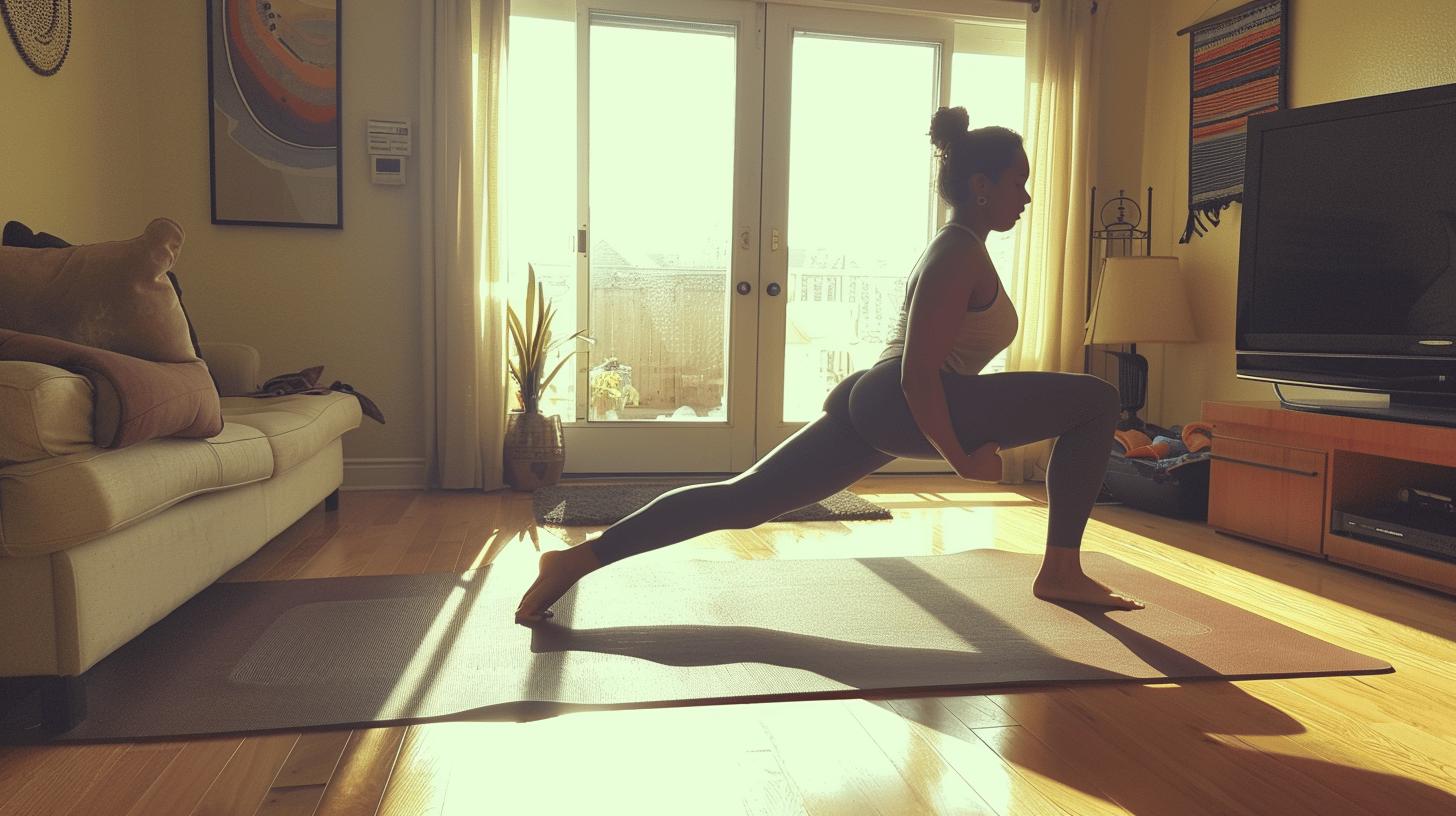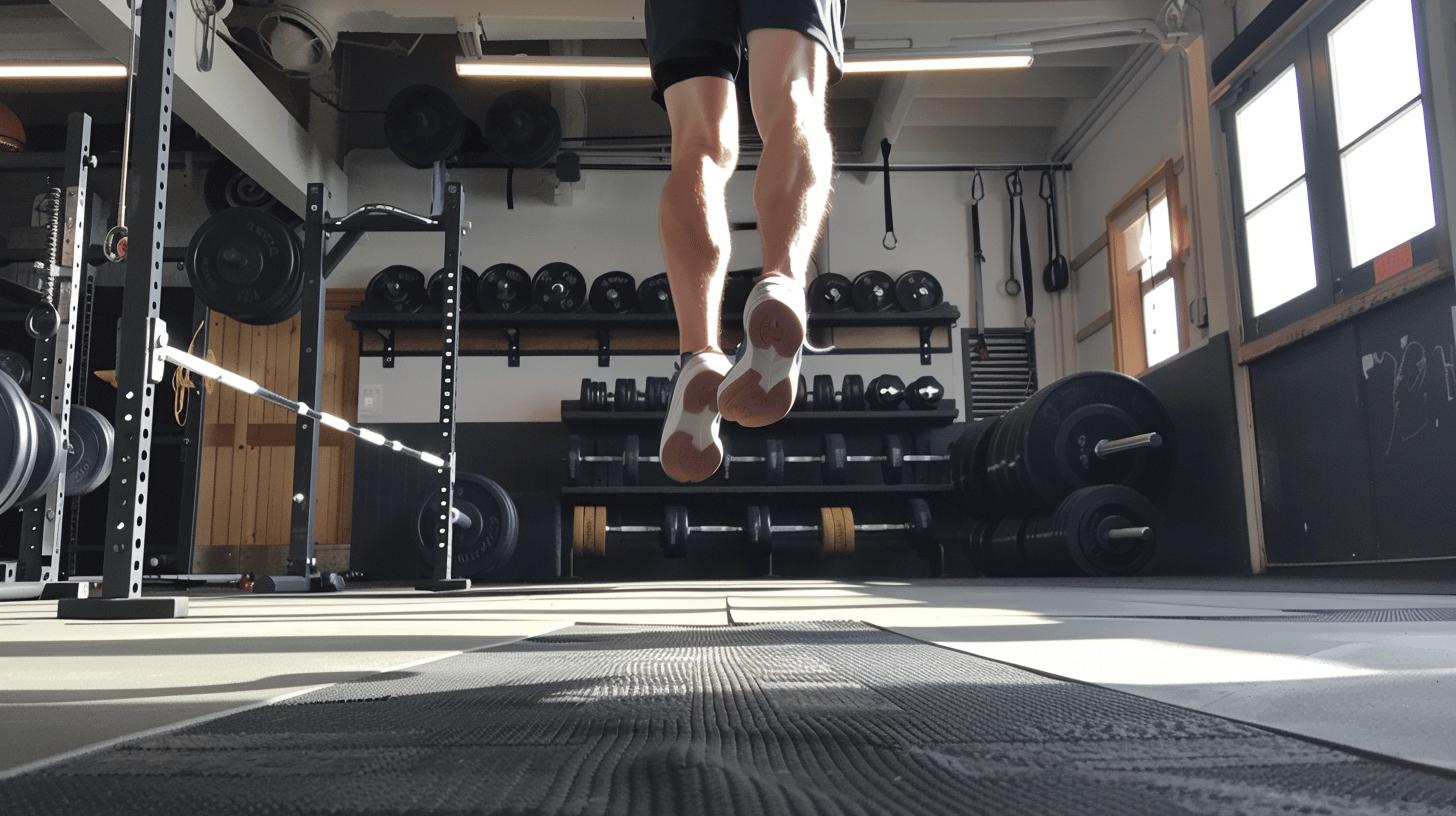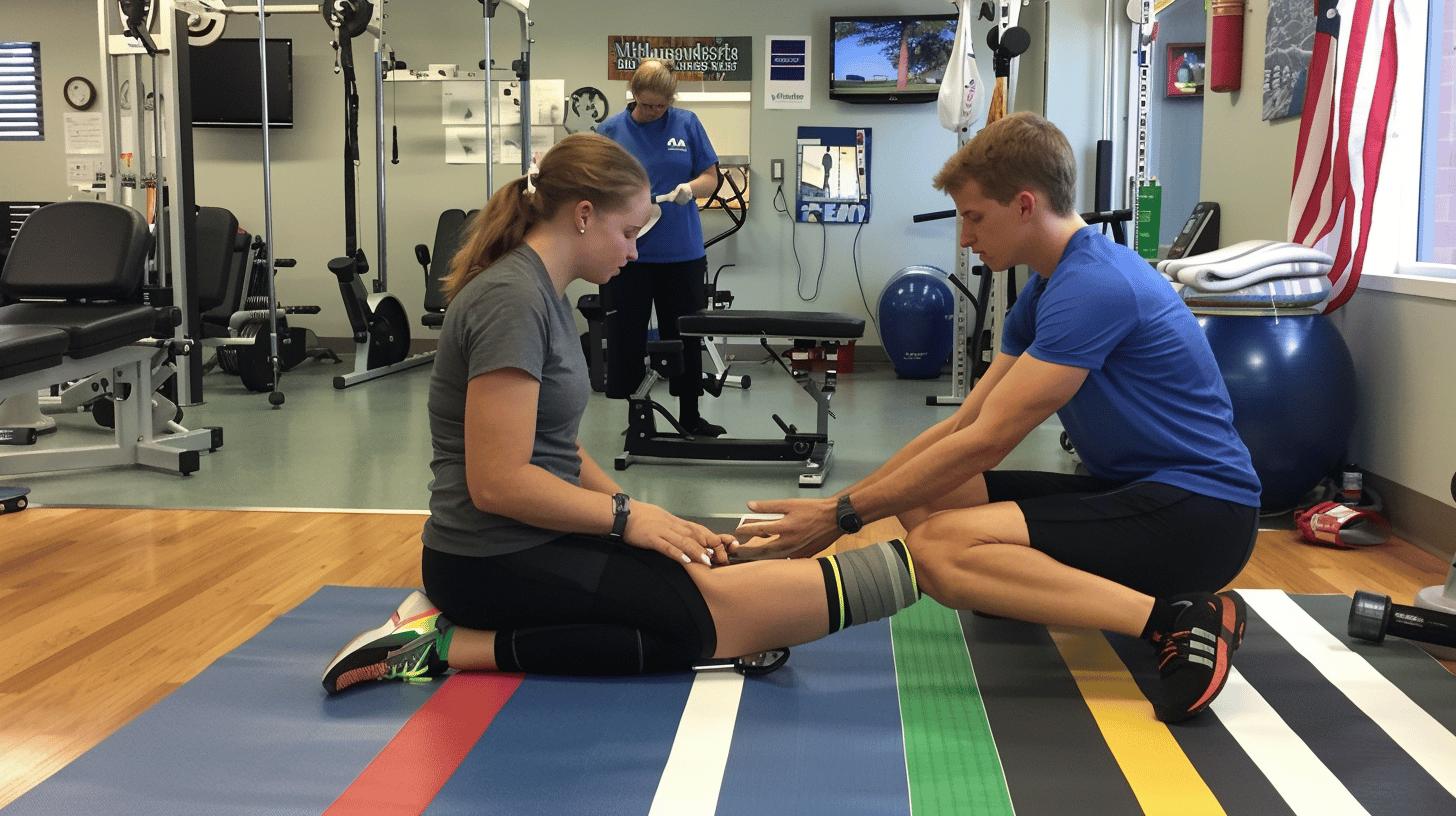Is accelerating your knee recovery after an ACL injury or surgery really possible? Yes, it is—if you incorporate the right strengthening exercises into your rehabilitation routine. Early-stage ACL rehab is crucial for restoring vital functions like knee extension, flexion, and normal walking patterns. By focusing on targeted movements and exercises, you can manage pain and build foundational strength, setting the stage for a faster recovery. This blog post will guide you through essential ACL strengthening exercises, beginning with what you need to do in the initial weeks to kickstart your recovery journey effectively.
Early-Stage ACL Strengthening Exercises
Early-stage ACL rehab aims to restore knee extension and flexion range of motion, normalize walking, and improve quadriceps function. These goals are essential to lay the foundation for more advanced rehabilitation phases, ensuring that the knee regains basic functionality before progressing to more strenuous activities.
Pain relief is crucial during early-stage ACL rehab, as it allows the knee to move with greater ease and facilitates the healing process. Monitoring the knee's response to exercises helps prevent overexertion and potential setbacks. Swelling and discomfort should be managed through proper rest, ice application, and anti-inflammatory medications as advised by a healthcare professional.
-
Heel Props: Sit with your leg extended and place a rolled towel under your heel. Allow your knee to straighten and hold for 10-15 seconds. Repeat 10 times.
-
Quad Sets: Sit with your leg extended and press the back of your knee towards the floor by tightening your quadriceps. Hold for 5-10 seconds and repeat 15-20 times.
-
Straight Leg Raises: Lie on your back with one knee bent and the other leg straight. Lift the straight leg to the height of the bent knee, hold for a few seconds, and lower it slowly. Perform 2-3 sets of 10 repetitions.
-
Knee Slides: Sit on the floor with your legs extended. Slowly slide your heel towards your buttocks, bending the knee as far as possible, then slide it back to the starting position. Repeat 10-15 times.
-
Balance Practices: Stand on one leg for 30 seconds, gradually increasing the time as your balance improves. Use a support if needed initially.
Progression and frequency of these exercises should be tailored to individual recovery rates. Generally, perform these exercises 2-3 times daily, gradually increasing intensity and duration as tolerated. Monitoring the knee's response and adjusting the regimen accordingly ensures safe and effective rehabilitation.
Quadriceps Strengthening Exercises After ACL Surgery

Quadriceps strengthening is vital for improving knee function and reducing the risk of re-injury after ACL surgery. Engaging the quadriceps helps stabilize the knee, supports proper alignment, and enhances overall leg strength.
Proper technique and form are crucial to ensure the effectiveness of quadriceps exercises and to avoid further injury. Always maintain a controlled motion, avoid jerking movements, and pay attention to alignment. Keeping the knee and ankle in line during exercises prevents undue stress on the joint. Engage the core to provide additional stability and support during each movement.
- Quad Sets: Sit with your leg extended. Tighten the quadriceps by pressing the back of your knee towards the floor. Hold for 5-10 seconds. Repeat 15-20 times.
- Straight Leg Raises: Lie on your back with one knee bent and the other leg straight. Lift the straight leg to the height of the bent knee, hold for a few seconds, then lower it slowly. Perform 2-3 sets of 10 repetitions.
- Leg Press: Use a leg press machine. Place your feet shoulder-width apart on the platform. Push the platform away by extending your knees, then slowly return to the starting position. Perform 3 sets of 10-12 repetitions.
- Step-Ups: Stand in front of a step or platform. Step up with one leg, bringing the other leg to meet it. Step down and repeat. Perform 2-3 sets of 10 repetitions per leg.
- Wall Sits: Stand with your back against a wall and slide down into a seated position, keeping your knees at a 90-degree angle. Hold for 10-30 seconds. Perform 2-3 sets.
Progression of these exercises should be gradual to match individual recovery rates. Start with minimal resistance and short duration, increasing as strength and tolerance improve. Typically, these exercises should be performed 3-4 times a week. Monitoring the knee's response and adjusting intensity accordingly ensures a safe and effective recovery process.
Hamstring Strengthening Exercises for ACL Rehab
Hamstring strengthening is crucial for reducing the strain on the ACL and promoting overall knee stability. Strong hamstrings help absorb the forces that would otherwise stress the ACL, facilitating a safer and more effective recovery post-surgery. Early-stage hamstring exercises focus on gentle contractions to re-establish muscle firing patterns, which is essential for regaining muscle control and preventing atrophy.
-
Slider Progressions: Lie on your back with your feet on a towel or slider. Bend your knees and slide your feet towards your hips, then extend them back slowly. Perform 2-3 sets of 10-15 repetitions.
-
Feet-Elevated Long Lever Bridges: Lie on your back and place your heels on an elevated surface like a chair. Lift your hips towards the ceiling, creating a straight line from your shoulders to your knees. Hold for a few seconds, then lower slowly. Perform 2-3 sets of 10 repetitions.
-
Hamstring Curls with Exercise Band: Attach an exercise band to a sturdy object and loop it around your ankle. Stand with your knees slightly bent and curl your heel towards your buttocks against the band's resistance. Perform 2-3 sets of 10-15 repetitions per leg.
- Prone Hamstring Contractions: Lie on your stomach with your legs straight. Gently contract your hamstrings, lifting your heel slightly off the ground. Hold for 5-10 seconds and repeat 10 times per leg.
Gentle progression and careful monitoring of the knee's response are essential. Start with low resistance and short durations, gradually increasing as strength and tolerance improve. Consistent assessment of swelling and discomfort allows for timely adjustments, ensuring safe and effective hamstring strengthening during ACL rehab.
Advanced ACL Strengthening Exercises

Transitioning to advanced ACL strengthening exercises is a pivotal step for individuals who have successfully moved through initial rehab stages. These exercises are designed to enhance knee stability, improve dynamic balance, and prepare the knee for more demanding physical activities.
Dynamic balance and plyometric exercises play a crucial role in advanced ACL rehab. They help in restoring proprioception, which is the body's ability to sense movement, action, and location. Plyometric exercises, such as jumping and landing drills, build explosive power and improve neuromuscular control. These exercises also train the knee to handle rapid changes in direction and high-impact activities, reducing the risk of re-injury.
- Bilateral Landings: Start with feet shoulder-width apart. Jump up and land softly on both feet, bending your knees to absorb the impact. Perform 3 sets of 10 repetitions.
- Bilateral Plyometrics: Begin in a standing position. Perform continuous jumps, focusing on soft landings and quick take-offs. Aim for 2-3 sets of 10-15 jumps.
- Unilateral Jumping and Landing: Stand on one leg and jump forward, landing on the same leg. Maintain balance and control during the landing. Do 2-3 sets of 8-10 repetitions per leg.
- Unilateral Plyometrics: Perform single-leg hops in place, maintaining a soft landing and quick rebound. Execute 2-3 sets of 10-12 hops per leg.
- Sport-Specific Drills: Incorporate movements that mimic your sport, such as lateral shuffles for basketball or sprint starts for track. Perform 3 sets of 10-15 repetitions.
Integrating these advanced exercises into a regular routine should be approached gradually. Typically, these exercises can be performed 3-4 times a week, with a focus on proper technique and controlled movements. As strength and stability improve, the intensity and volume can be increased. Regular monitoring and adjustments based on knee response are essential to ensure safe progression and effective recovery.
ACL Strengthening Exercises to Prevent Injury
Preventing ACL injuries is crucial for maintaining knee health and avoiding long-term complications. Strengthening exercises play a significant role in injury prevention by improving knee stability and enhancing muscular support around the joint. Proper technique and form during these exercises are vital to ensure effectiveness and reduce the risk of further injury.
-
Y Balance: Stand on one leg and reach the other leg forward, to the side, and backward, forming a "Y" shape. Perform 2-3 sets of 8-10 repetitions per leg.
-
Single-Leg Romanian Deadlift (RDL): Stand on one leg, hinge at the hips, and lower your torso while extending the opposite leg behind you. Return to the starting position. Perform 2-3 sets of 10-12 repetitions per leg.
-
Lateral Hops: Stand on one leg and hop side-to-side, maintaining balance and control. Perform 2-3 sets of 10-15 hops per leg.
These exercises should be performed 3-4 times per week, with gradual progression in intensity and volume. Start with lower repetitions and increase as strength and balance improve. Monitoring form and knee response ensures safe execution and effective injury prevention.
ACL Rehab Programming and Monitoring

Structured ACL rehab programming begins with early-stage exercises and progresses through mid-stage activities, ensuring a gradual and safe recovery. The initial stage focuses on restoring range of motion, reducing swelling, and improving quadriceps activation. As recovery advances, mid-stage activities aim to build muscle strength, enhance proprioception, and improve functional movements. Each stage is designed to prepare the knee for the next level of activity, ultimately restoring full functionality and stability.
Monitoring pain, swelling, and joint soreness is crucial throughout the rehabilitation process. Regular assessment helps in adapting exercises based on the knee's response, preventing flare-ups and setbacks. Adjustments should be made according to the patient’s progress, ensuring exercises are performed within a pain-free range and that swelling is managed effectively. Ice application, rest, and anti-inflammatory measures are often recommended to control symptoms.
| Stage | Focus |
|——-|——-|
| Early-Stage | Restore range of motion, reduce swelling, improve quadriceps activation |
| Mid-Stage | Build muscle strength, enhance proprioception, improve functional movements |
| Late-Stage | Return to sport-specific movements, advanced strengthening, dynamic balance exercises |
Reintroducing running and other high-impact activities should be based on objective functional criteria, such as strength and stability benchmarks. A gradual return is essential, starting with low-impact activities and progressively increasing intensity. Criteria may include the ability to perform single-leg squats without pain, achieving a certain degree of knee flexion and extension, and having no significant swelling or instability. Regular monitoring and adherence to these criteria help in safely reintegrating high-impact activities into the rehab program.
Final Words
In the action, effective ACL strengthening exercises are critical for successful rehabilitation and injury prevention. Early-stage exercises focus on restoring knee motion and normalising walking. Quadriceps and hamstring strengthening are vital for improving function and reducing re-injury risk. Advanced exercises, including plyometrics and balance work, enhance stability.
Consistency and proper technique are key to meeting rehabilitation goals. ACL strengthening exercises, when appropriately applied, foster recovery and prevent future injuries. Commitment to a structured rehab program ensures optimal outcomes and a positive return to physical activities.
FAQ
How do I make my ACL stronger?
Strengthening your ACL involves focusing on exercises that enhance the surrounding muscles, specifically the quadriceps and hamstrings. Key exercises include quad sets, straight leg raises, and hamstring curls.
What muscles strengthen the ACL?
The quadriceps and hamstrings play vital roles in stabilizing and supporting the ACL. Strengthening these muscle groups can help protect the knee against injuries.
Can ACL heal by exercise?
Exercise alone cannot heal a torn ACL. However, specific exercises can strengthen the surrounding muscles and improve knee stability, which can help manage symptoms and prevent further injury.
How do you know if your ACL is weak?
Signs of a weak ACL include knee instability, difficulty with pivoting movements, pain, and swelling after activity. Consult a healthcare professional for an accurate diagnosis.
What exercises should be avoided with a torn ACL?
Avoid high-impact activities, deep squats, pivoting, and twisting movements. These exercises can exacerbate the injury and delay recovery.
What are some early-stage ACL strengthening exercises?
Early-stage exercises include heel props, quad sets, straight leg raises, and balance practices. These exercises help restore knee extension, normalize walking, and improve quadriceps function.
What exercises are recommended post-ACL surgery?
Post-ACL surgery, focus on quadriceps strengthening with exercises like quad sets, straight leg raises, leg presses, and hamstring strengthening with slider progressions and long lever bridges.
What are some ACL prevention exercises?
Prevention exercises include dynamic balance activities like Y Balance and single-leg Romanian Deadlifts (RDLs). Proper form during physical activities is critical for injury prevention.
What are advanced ACL strengthening exercises?
Advanced exercises include plyometric drills, dynamic balance exercises, and sport-specific movements like bilateral landings, unilateral jumps, and deceleration exercises. These help improve functional performance.

